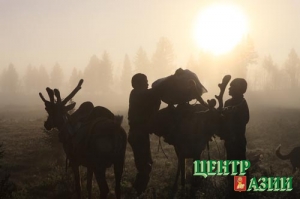
Experience of nomadic life
The map of the Todzha district of Republic Tuva was spread out over the entire wall of the socio-economic department of the administration. It did not show highways or roads for cars, none with covered tops neither without it. Only four canvas tents with chimney pipes of “burzhuyka” stoves sticking out remind us that people live here. Everything else is a painting without artefacts. 19th century ethnographers used to describe the common nomad grounds of several families, forming a single camp – aal – as a nomadic neighbor community. It could consist of relatives, or of people without any blood ties. There is nothing aside from some unpaved roads and horse paths. But everywhere there are blue lines – network of rivers that firmly bind the Todzha valley. The map does not show any industrial or cultural points. Not counting the settlements, there are only mining areas, hunters’ and fishermen’s cabins, and several arat farms. The rest of it is taiga and mountains, rivers and lakes.
And especially, the map does not show any flags of the reindeer herders’ camps.
Only the approximate territories where the reindeer herders might be camping in the summertime are known – in the valley of Serlig-Khem tributaries, on Izyk-Sug near the mineral spring of Choigan, and somewhere by the source of Khamsara. To get to the reindeer herders in the summer, because of rains, flooding rivers, swamps, and lack of knowledge of the precise co-ordinates, is practically impossible.
But we made it.
In search of the real ones
The session by the map in the district administration office, studying the dislocations of domestic reindeer was useful and discouraging.
A trip to the mineral springs Choigan takes a week on horses under conditions of good weather, without rains, otherwise one simply gets stuck in the marshes. But in the summer horses are scarce in Toora-Khem – Tuvans flock to the arzhaans for rest cures with whole families.
Another possibility is to get a radio connection with Chazylar, the most distant settlement on Khamsara river. They might be planning to make a trip to see their reindeer herders, for example, to deliver stuff. Even though there have been no regular supply deliveries, or medical and veterinary visits in a long time. Everybody for himself.
“It would be much simpler to go to Syynak, that is easier to reach, - the consultant from the socio-economic development of Todzha district advised us, - there are reindeer there too. What is the difference?”
Syynak is a detour on the road between Boyarovka and Toora-Khem. After the first mountain pass it is a piece of cake. They have a small herd of reindeer, the owners of the restaurant keep them. Reindeer goulash is on the menu.
The reindeer circle around the cars, scratch their shedding hips on the wooden cabins, let people pet them, photograph them. A little boy, the son of the owners, warns the spectators with cameras; one photo costs 20 rubles.
Yes, there are certainly reindeer here, but there are no reindeer herders. For us, three pilgrims from a great settled country it makes a tremendous difference.
We need specifically the reindeer herders – the real ones.
Nikitin’s plan
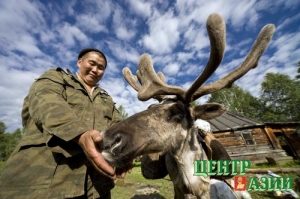 There is a feeling that all the inhabitants of Toora-Khem worry only about how to get us to the reindeer herders. There is a feeling that all the inhabitants of Toora-Khem worry only about how to get us to the reindeer herders.
Already on the way to the settlement, ny co-travelers stormily evaluated all the possible variants, advised, encouraged, suggested to whom to turn: nature reserve ”Azas”, MUP ”Odugen”, the farm, the district administration.
But one woman told us that if we really need to go there, everything will work out. She said it calmly, with confidence, and with a slight smile.
She was right, because everybody around us tried to help. Some wished us luch, others brought fresh milk to the guest house.
Finally, I was sent to Yuri Nikitin, the chief expert in hunting in the district. He knows a lot, perhaps he will suggest some workable plan. And this person solved everything.
As I reached a radio connection with Chazylar at the “Azas” nature preserve, and was figuring out the weight of the cargo that a reindeer can carry over the loud crackling of the connection, Nikitin thought out the plan of action.
He read the map in his own way. In every quadrant of the family reindeer pastures, he saw people: relatives, friends, acquaintances of the reindeer herders that we were seeking. Those who could be sought out in the settlements, who could guide us to the place. He already had a list of candidates on his desk.
We started action according to Nikitin’s plan. The operation “to find Khayadyr’s son-in-law” was successful. Having combed through the Iy settlement and Adyr-Kezhig, we found Mergen.
There they are, your reindeer!!
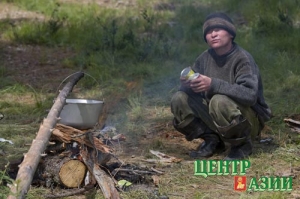 Mergen Sanai-ool is married to the sister of a young reindeer herder, Omak Baraan. Mergen Sanai-ool is married to the sister of a young reindeer herder, Omak Baraan.
He has a little daughter, but his older son already goes to school. He lives in Adyr-Kerzhik village. He works as a hunter, but the family is fed, mostly, by the tractor
and the taiga. In the summer, he mows and transports hay, in winter, he chops wood for people.Omak brought reindeer and horses to the abandoned mine that same day. But we were still repairing the engine of the GAZ-66, halfway there, and soaking our feet in the Myun-Khol lake.
That is why we got there in the middle of the night, without losing the way wandering among the mountain ridges. The truck headlights tried to attack the fog, but it was hiding behind a veil of clouds.
We could see from the truck that the stars were lying at the feet of the cedars, and it seemed that the truck was rising vertically like a rocket. A rainfall suddenly broke out and poured into the truck like a cold shower. We were certain that the loud roar of the engine could be heard where we were expected.
“There they are, your reindeer! Their waiting is over!” – said Mergen triumphantly as soon as the truck stopped.
Velvety antlers, lit up by the headlights of the truck, blended with the tree branches.
All-terrain vehicle with antlers
Our caravan, consisting of four reindeer, three horses, two stallions, and a dog named Kulak, ascended from the abandoned mining settlement Kharaal.
There were six of us in the expedition. Misha Genis, the photographer, his wife Vika and myself. There were three guides – Omak, Mergen, and Kostya.
Omak says that we started out too late, even though it is around nine in the morning. In three hours, we will be suffering in the heat of the sun. But it is not us he is thinking of, but the reindeer.
The reindeer do not have any sweat glands, and the cooling of the organism is done by breathing through the mouth. The hot streams of air singe the lungs The reindeer becomes short of breath, can collapse and die. The horses do not like the heat either, but they handle it by becoming drenched.
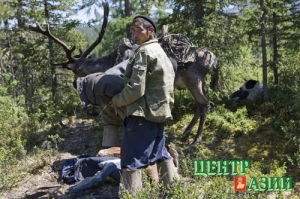 It is said about the reindeer: you beat him, he is silent; you feed him, he is silent; you whip him, still remains silent. He submits to everything meekly accepts the inevitable. It is said about the reindeer: you beat him, he is silent; you feed him, he is silent; you whip him, still remains silent. He submits to everything meekly accepts the inevitable.
If a bear shows up next to him, he simply freezes and will not budge.
My reindeer has the largest antlers.
He can accurately and precisely push this branchy crown between the tree trunks without touching them. But I get slapped by tree branches.
The kids on horseback ride in the front. At times our paths separate, because the marshy parts of the path are not passable for horses. They have to go around the sides. But out antlered all-terrain vehicles go through easily.
The reindeer does not pay any attention to the fact that the depths of the swamp could swallow us in a single moment. He walks calmly, just like down an avenue.
Mergen walks next to me, more often on foot than on a reindeer. He does not want to be saddled. But Omak says that the reindeer has a bad leg, and with a load it hurts him more. So he does not walk.
Mergen asks if we happen to have a chess set. It sounds quite unexpected in these surroundings.
Without a map
Omak does not need a map. We have printouts of the quadrants of the area in our backpacks, and a GPS navigation device in the pocket. But it is all nonsense in comparison to a reindeer.
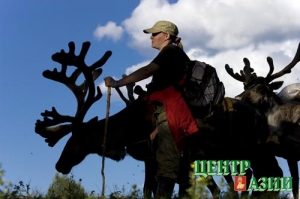 Omak trusts his reindeer to such an extent that he sleeps while riding. With his body upright in the saddle, head drooping a little, a lead in one hand, a stick in the other. And he himself is fast asleep. Omak trusts his reindeer to such an extent that he sleeps while riding. With his body upright in the saddle, head drooping a little, a lead in one hand, a stick in the other. And he himself is fast asleep.
The reindeer sometimes abuses this comfortable situation to veer from the path towards some overgrowths of lichens and moss. If he sees any mushrooms, he sucks them up like a vacuum-cleaner. Then Omak gets smacked on the face with a tree branch and wakes up.
He does not look like a Tuvan. He has light hair, pale skin. The others call him Russian among themselves. He served in the army. In Kamchatka. In the fleet.
All those who served in the army speak Russian very well. Kostya, the third guide, turned 18 only recently, so he just nods to everything and smiles. He understands, but speaking is a problem.
Omak, his wife and children always spend the whole summer together. Their older son, Uran-saai, goes to school, and the little daughter is still stuck to mom’s skirts. In the camp, they call Omak’s wife Alla Borisovna. She looks like Pugacheva.
Omak’s brother Yuka helps with the reindeer. In the middle of the 90’s, Omak dropped out of school, deciding that studying, at that time, was useless. And he left for the taiga. There was nothing to do in Adyr-Kezhig. There was just drinking and starving.
Different taigas
It takes two days to get to the camp. It is located somewhere near the source of the river Khan. It is a tributary of serlig-khem.
Omak only shrugs his shoulders when asked about kilometers.
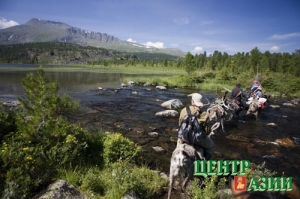 That system of counting is useless here. You can’t measure strength in kilometers. If you still have strength – keep going. If not, pull yourself together and keep going. That system of counting is useless here. You can’t measure strength in kilometers. If you still have strength – keep going. If not, pull yourself together and keep going.
He shrugs his shoulders altogether too often. But as we get to an open place, he stretches out his stick like a pointer and says: “Our reindeer are right behind that taiga!”
The horizont is circled by a wreath of pointy mountains, with glittering spots of snow. The cedars get closer to the peaks that the other trees, leaving the fir and larch jungles behind.
Taiga is all around, intermixed with mountain tundra, which is beginning to get squishy from the burning sun. How can one see any point of difference in this chaos – a taiga behind which there are reindeer?
How can you see another taiga, when you are in the taiga? Following with my eyes on the map the direction of Omak’s hand, I nod, as if I can see the taiga tha he is pointing out, but the system of co-ordinates remains incomprehensible to me. The difference is in the interpretation. For me – taiga is a forest, endless and all-encompassing, in which if you leave the path, you can lose the way and get lost.
For Omak – taiga is his home. Reindeer live there, and he lives there. It is an open, not forested, area on tops of mountains, where water gathers to run to the rivers, where among scattered rocks there grow lichens, mosses, and dwarf birch trees, and badan and koshkara bloom.
That is where reindeer find nourishment. In our language, they are bare mountaintops. Every house has an address, and every Taiga has a name.
The chain of bare mountaintops which gather water to Serlig-Khem is called Ulug-Taiga (The Great Taiga) – is the eastern part of Academician Obruchev’s Ridge. But every single elevation of this chain has its own name. Then one can understand how Omak can see different taigas.
They and us
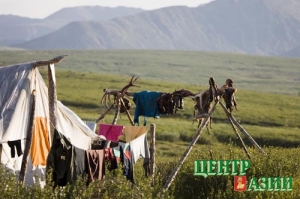 There are three of them. There are also three of us. The kids never take off their hats and jackets, regardless of the fact that the air is vibrating from the sun. Just like the Uzbeks, who are always dressed in their felt coats, no matter what the weather is like. There are three of them. There are also three of us. The kids never take off their hats and jackets, regardless of the fact that the air is vibrating from the sun. Just like the Uzbeks, who are always dressed in their felt coats, no matter what the weather is like.
We took everything off down to the t-shirts, and instead of a suntan, we are getting sunburn.
They speak very quietly, barely moving their lips, yet they hear each other and can have a conversation at any distance.
We yell, shout, keep asking questions, and still can’t hear anything until we are nose to nose.
They move around and do everything without hurry, slowly at first sight, yet everything is quickly done.
We hurry and try very hard, yet we do not manage to get anything done at all.
They can squat on the ground for hours, while we don’t even try it, knowing the consequences.
Lounging on reindeer hides around the fire, they hardly sleep at all, disturbing the night with a language incomprehensible to us.
We sleep in tents with our hind legs sticking out, and, crawling out of our warm cocoons into the frosted morning, we see that the horses are already saddled, the reindeer loaded, and there is tea on the fire.
They can’t live without meat and dream about getting to camp and killing an animal.
We can live on “Rolton” noodles and sardines in tomato sauce, and we make sure to put an extra little bit of stew on their plates.
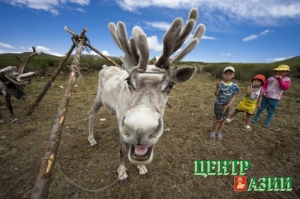 They are always trying to point out deer, mountain goats, moose running by, but our eyes could not see them even with binoculars. You had to look right away, Omak likes to answer to the machine-gun-like rattle of questions - where, where, where? They are always trying to point out deer, mountain goats, moose running by, but our eyes could not see them even with binoculars. You had to look right away, Omak likes to answer to the machine-gun-like rattle of questions - where, where, where?
But if one tries to turn off one’s busy world, one can see at least traces of the life that is invisible to us: hoofprints in the soil, earth ripped up by wild boars, tops of cedars broken by bears. And one can hear the cry of a mountain goat and the clapping of partridge’s wings.
They enjoy frightening us a little bit, making noises in the bushes or imitating the roaring of a bear. Omak makes the animal sounds, Kostya asks – did you hear those weird sounds – and Mergen at the same time produces rustling in the bushes.
We play along and flinch.
Ak, Kol, Baraan – my Todzhans!
The reindeer were panting like exhausted dogs. The last kilometers after the two-day passage under the burning sun were especially hard on them.
Mergen’s reindeer tripped in the marshy ground and fell over with his load, twisting his neck. His tongue protruded and started turning white right in front of our eyes.
Already the second day Omak has been leading this reindeer together with his own.
He was very weak from the heat. And Mergen walked the whole trip.
“If he gets up by himself, he’ll live,” – said Omak, removing the load and saddle from the barely breathing animal.
After another half hour we reached the place. Children of various ages attentively watched our weird faces, while the men cleared the undergrowth from an area for our tent.
After having the loads taken off, the reindeer tiredly went off to their relatives.
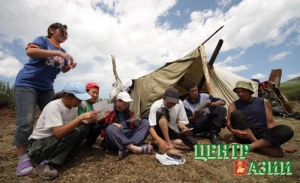 This desert-like mountaintop is called Byurek-Taiga. In translation from Tuvan it means a bud. And really, on the background of the surrounding massive bare mountaintops, the place appeared as a little bulge, convexity, a swelling bud. This desert-like mountaintop is called Byurek-Taiga. In translation from Tuvan it means a bud. And really, on the background of the surrounding massive bare mountaintops, the place appeared as a little bulge, convexity, a swelling bud.
All the families of the camp, independent of family affinities, would graze the reindeer together, build storages for food and winter equipment, and together the shared out the meat of hunted wild animals.
Each aal had usually a more or less constant territory of pastures, camps and hunting areas common for all the families.
Everything remains just like in the 19th century. Except instead of the chooms, there are tents, clothing is covered with “BOSS” labels, reindeer skins are cleaned with “Fairy” cleaner instead with snow, and the children demonstrate their degree of globalization by using the “American fig”, a well-known configuration of fingers.
But the unshakeable basics are - mutual help, and belief that every Taiga has its master. The higher the Taiga, the more powerful and more deceitful is its master. That is why it is impossible to ascend to the highest bare mountaintop, Kush-Taiga. Wind is the master there.
One zootechnician dared to go there, and the wind took his soul. That is what they say. The body walks, wanders around, but the soul walks somewhere else.
All four families are simply neighbors, regardless of the fact that most of them have the same family name. The greater proportion of the people in the camp are named Kol and Baraan.
“Ak, Kol, Baraan, my Todzhans!” says one of the songs. Those are the three main clans of Tuvans – Todzhans.
Two of the families are young parents with children, the other two are also parents, but with grown children, who now live in Kyzyl.
Terror in the morning
The reindeer grunt, especially when they feel good. Otherwise they are silent. The grunting is quite unexpected, and those not in the know may think that pigs are hiding somewhere nearby.
They feel good when somebody feeds them salt. And they grunt with doubled strength
if they manage to get a hold of some salty snack independently.
Human organism excretes salt in a natural way, and the places where these excretions are concentrated attract the reindeer. There was one such place at the camp, in the bushes.
Every morning, an antlered gang stood guard next to our tent, and as soon as the sleepy people emerged for their morning call of nature, the reindeer gang raced after us.
Trying to talk them into going aside and stop bothering us, or even just not to look, were useless. The reindeer surrounded us on all sides, insisting that we immediately produce a serving of salt.
They were so pushy that we could not even squat down. Misha had an especially difficult time. The most daring individuals would even poke with their hooves at the tent at dawn, trying to get the proceedings started. Willy-nilly, we had to come out.
The reindeer left their own people alone. The morning rule of terror was only for us.
To be continued.
Photos by Mikhail Genis.
- Mergen Sanai-ool. Salty palms are very tasty.
- Omak Baraan: “Of course, stew is not meat. But on an expedition, we can tolerate it!”
- Guide Kostya. The reindeer have to be unloaded in the heat.
- My reindeer has the largest antlers! Anastasia Veshchikova on the Todzhan all-terrain vehicle.
- The road to the Great Taiga. Two days to the camp.
- The house of a reindeer herder.
- One of the dawn terrorists – tied up.
- The people of the camp and Byurek-Taiga are looking at photos of their neighbors – Soyots of the Oka district in Republic Buryatia.
|
